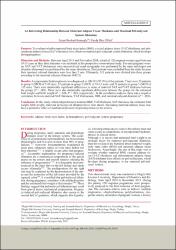An Interesting Relationship Between Maternal Adipose Tissue Thickness and Maternal Pelvicalyceal System Dilatation
Abstract
Purpose: To evaluate whether maternal body mass index (BMI), visceral adipose tissue (VAT) thickness, and subcutaneous adipose tissue (SAT) thickness have effects on maternal pelvicalyceal system dilatation, which develops during pregnancy. Materials and Methods: Between April 2018 and November 2018, a total of 120 pregnant women aged between 18-35 years in their third trimester were included in this prospective observational study. For each pregnant woman, SAT and VAT thicknesses were measured and renal sonography was performed by the same radiologist and obstetric ultrasound was performed by the same obstetrician. Nine patients were excluded from the study because their maximal caliceal diameters were less than 5 mm. Ultimately, 111 patients were divided into three groups according to the maximal calyceal diameter (MCD). Results: Asymptomatic hydronephrosis was diagnosed in 108/111 (97.3%) of the patients. There were 53 patients in group 1 (MCD of 5-10 mm), 39 patients in group 2 (MCD of 10-15 mm), and 19 patients in group 3 (MCD of >15 mm). There were statistically significant differences in terms of maternal SAT and VAT thickness between the groups (P=.001). There were also statistically significant differences between the groups for the estimated fetal weight and birth weight (P=.024, P=.003, respectively). In the correlation analysis, there was a negative correlation between maternal SAT thickness, VAT thicknesses, BMI, and maximal calyceal diameter (P=.001). Conclusion: In this study, relationships between maternal BMI, VAS thickness, SAT thickness, the estimated fetal weight, birth weight, and renal pelvicalyceal dilatation have been shown. Increasing maternal adipose tissue may have a protective effect of mechanical pressure of growing uterus on the ureters.


















